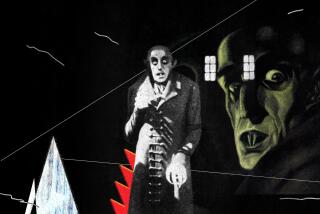The rock novel to end all rock novels: Jeff Jackson’s ‘Destroy All Monsters’
- Share via
The only art form declared dead as generally as the novel is rock ’n’ roll, and so the rock novel should be doubly doomed. It doesn’t help that the subject is so … elusive. Cue Frank Zappa’s snappily convincing axiom: “Writing about music is like dancing about architecture.” (And writing this review was not immune.)
It’s no surprise, then, that some of the best rock novels are hardly about music at all. Consider Dana Spiotta’s cerebral and affecting “Stone Arabia,” which uses rock like a canvas, painting portraits of obsession and family mythology. Steve Erickson’s overwhelming “Shadowbahn,” despite its musicophilia, is really about the composition of the American Songbook, 9/11 and political death. Don DeLillo’s occasionally gleeful and wonderfully conspirative “Great Jones Street” is about an enigmatic and colossally famous rock god in hiding, but, of course, the book is really about celebrity. And paranoia. And drugs. In fact, the evidence largely suggests that “rock ’n’ roll” — the actual music — plays a mostly peripheral part in the rock novel proper. (A very un-rock ‘n’ roll phrase, if I’ve ever used one.) The music, instead, becomes context for more pressing, and possibly more interesting secondary dramatic projects.
Enter Jeff Jackson’s crackingly ambitious new novel, “Destroy All Monsters: The Last Rock Novel,” wherein he gutsily half-disproves my theory. It’s about bands and band practice and torn ticket stubs, gig fliers, amplifiers, guitars, drums, long hair, dyed hair, scenes, stall graffiti and mix tapes. More, it imbues them with a power that only a true fan’s cataloging can provide.
Here’s Jackson, cannily, and loyally, on waiting in line for a show: “Drivers cruise the streets in search of parking spaces, gliding past the ticket holders streaming toward the show and the onlookers loitering under streetlights. Normally people come to make the most of their hours away from jobs at the wheelchair factory, the tire warehouses, and construction gigs, but this crowd has flocked here for the homecoming show of a local band whose songs have gone viral. Their attention is riveted on the theater, its facade lit up like a beacon. A bustling queue of teenagers wraps along the building’s perimeter, bodies pressed tight to keep a claim on their territory. They’ve camped out on the sidewalk for hours, dressed light in anticipation of spring weather that hasn’t arrived, a sampling of what passes for an underground scene in this conservative industrial city. The strip-mall goths, the mod metalheads, the blue-collar ravers, the [dirty] punks, the jaded aesthetes who consider themselves beyond a category. Everyone in line had imagined a night that could crack open and transform their dreary realities. This is it.”
Jackson gets this right. The experience of rock, especially the punk rock of this book, is about music and identity, experience and stuff. There is a visual aesthetic inextricably connected to the songs we love. And “Destroy All Monsters” physically claims that aesthetic. Composed of both an A side and a B side, the book is conversely bound (start with either side, just flip it), sporting graphic art on both covers that might easily grace a punk or indie 7-inch from the ’70s, ’80s or ’90s. Not to mention the title echoes a schlocky ’60s monster movie. The book is a startlingly delightful pop object.
All of which diametrically prepares the reader for a novel that is formally complex, experimental, poetic, puzzling, often uncomfortable, at times dizzying, always alive, beautifully written and just plain daring. The plot, though, is rather straightforward: Xenie and Shaun are part of a small-ish town’s fading rock scene (I often thought of Sonic Youth’s song “Chapel Hill”; Jackson is from North Carolina); and at different times they obsessively fan-boy/-girl over bands, while at others they make music. Amidst all this comes a scarily relevant red wave of murderous violence, a nationwide “epidemic” of people bringing guns to rock shows and killing the players. There is blood. People die. But how will Xenie and Shaun fair? Will they kill? Will they be killed? The questions hover over this dispersive novel like feedback resounding lowly.
Which brings us to Jackson’s distressingly bold second subject — one that also happens to be (I’d argue) the seed subject of rock ’n’ roll. In the words of Iggy Pop: “Gimme danger, little stranger / And I feel with you at ease / Gimme danger, little stranger / And I’ll feel your disease … .” The Stooges know what we want. Jackson does too. Think of Little Richard’s “Tutti Frutti” homoeroticism in a 1950s gospel South; of Black Flag’s brutal sonic assaults; of Kathleen Hanna’s fierce stabs at patriarchy; of Death Grips’ genre-destroying maelstrom (I could easily go on). There is but one pioneering continuous vital thread in the force that is rock ’n’ roll: danger. It is the starting gate and horizon. It’s the machinery, fire and fuel.
“Destroy All Monsters” dares pair a most troubling aspect of contemporary life in the United States, mass shootings and the proliferation of guns, with the romantic desire for “danger” that runs in the blood of rock ’n’ roll. And the link? A search for authenticity. “These bands are poisoning something that used to be meaningful,” Xenie says. “Their music is actually toxic.” It’s a risky idea, unsettling, and plausibly offensive; one might even call it dangerous. Which is pretty rock ’n’ roll, if you ask me.
Cheshire is the author of the novel “High as the Horses’ Bridles.”
::
“Destroy All Monsters: The Last Rock Novel”
Jeff Jackson
FSG Originals: 384 pp., $16 paper
More to Read
Sign up for our Book Club newsletter
Get the latest news, events and more from the Los Angeles Times Book Club, and help us get L.A. reading and talking.
You may occasionally receive promotional content from the Los Angeles Times.






